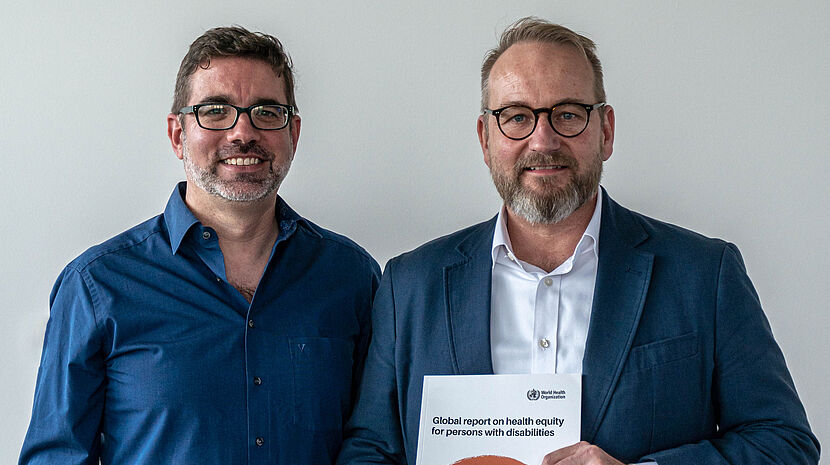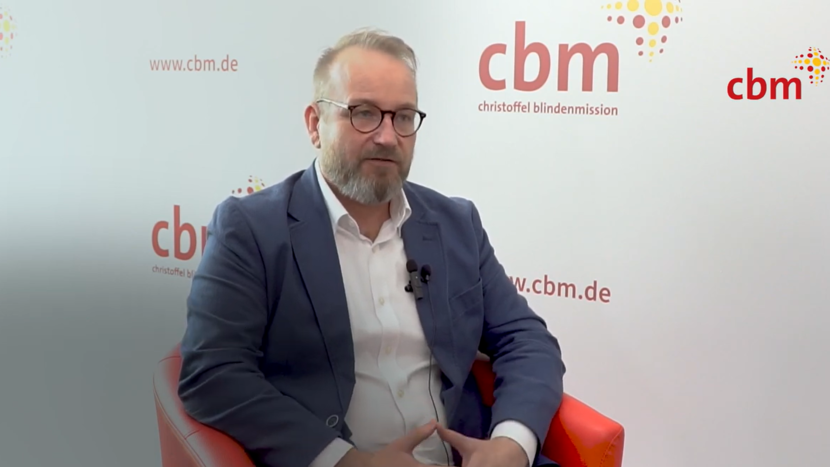Investing in Health Equity for Persons with Disabilities Returns More Benefits

Michael Schwinger (L) Specialist Technical CBID Advisory Lead at CBM receives the report from Darryl Barrett (R), Technical Lead for Disability Programming at WHO
©CBM
More than 1.3 billion people in the world experience significant disability. That's 1 in 6 of us. Yet persons with disabilities still face many unacceptable health inequities. These include earlier death (20 years), double risk of developing certain health conditions, and limitations in day-to-day functioning.
Health equity for persons with disabilities and equal access to health are at the heart of CBM's work.
As a recognised disability-inclusive development organisation with consultative status at the United Nations, CBM was part of the technical expert group in the production of a new World Health Organization (WHO) report: Global Report on Health Equity for Persons with Disabilities.
Darryl Barrett, the Technical Lead for the Disability Programme at WHO, presented the report to CBM last week.
In this abridged interview, Barrett discusses the technical collaboration between CBM and WHO in ensuring equitable health care for persons with disabilities. The full video interview can be found below and on YouTube.
Why is the Global Report on Health Equity for Persons with Disabilities important?
The report provides new evidence and analysis of issues related to health equity for persons with disabilities. Health equity means ensuring that people have access to the health services they need. It means removing any avoidable obstacles or challenges that might make it difficult for them to access these health services.
It's been about ten years since the WHO produced the World Report on Disability in collaboration with the World Bank. So, we needed now to introduce a focus on health and health equity for persons with disabilities.
What are the key findings? What figures shocked you the most?
The first concerns premature mortality: [persons] with disabilities are dying up to 20 years younger than the rest of the population. The second relates to health conditions. Many [persons] with disabilities are at double the risk of developing a range of health conditions such as depression, diabetes or cardiovascular disease. And thirdly, there are increased limitations in their day-to-day functions due to certain barriers in their environment.
For me personally, the earlier death of persons with disabilities was a really shocking finding.
Why is the cooperation between CBM and WHO important and what role did CBM play in the report?
CBM has been a valuable partner [of WHO] for many, many years, especially in the area of disability. Given CBM's experience in a number of countries around the world, it was crucial that CBM was involved in the development of the report. CBM was part of our technical expert group to give us input and feedback for the development of the report.
What are the implications for low-income countries and why is it important for their governments to create equitable access to health services from the start?
Conversations about disability are often about how much it will cost to be disability inclusive. We present some economic analysis that says: when governments take a disability-inclusive approach, it means they are making a smart investment in the health sector that will return more benefits for us. This is a key element of the report for low- and middle-income countries.
What relevance do the findings have to the development of the next Global Disability Summit in 2025?
For 2025, we can incorporate the evidence and recommendations of the report into the Global Disability Summit. Governments and partners will now have more opportunities to understand what needs to change in the health sector moving forward.
